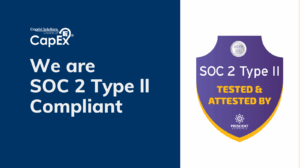Planning Capital Expenditure is a critical part of investment that help organizations gain greater visibility into whether or not to delay or accelerate spending. CapEx is essential to company growth, and projects like new retail stores and facilities, or capital outlay for things like furniture and computers need closer examination before moving forward with a project. Large expenditures have a major impact on cash flow, and require input from all stakeholders.
That’s why everyone internally needs visibility into CapEx projects and portfolios.
Investments need to be reviewed by all stakeholders – from upper management, to leadership and execs, and cross-departmentally; everyone needs to be in-the-know about which projects need attention to ensure that the right investments are being spent time and money on, and that the right resources are being used. Measuring one investment against another is a critical process to undertake in order to make the most lucrative decisions.
Leadership needs to take part in the Capital Expenditure process. But, how do we enable the whole organization – from one department to another, to review all projects in the most effective and efficient way possible in order to be effective and efficient?
Forward-thinking companies are making visibility a reality by investing in tools to manage capital projects so that everyone has a bird’s-eye view into a particular project.
And, how does a healthy capital project plan look?
When the right tools are in hand, CapEx planning makes approvals easier to manage. Proposals are evaluated to set a strategic and tactical approach to weigh against a range of ROI alternatives. Final decisions have long-term consequences on cash flow. That’s why project owners need to be diligent at justifying proposed portfolios against ROI. Once the numbers are crunched, a projection needs to take place based on the asset type and estimated procurement price. It is then in the hands of Finance to review the proposals and make adjustments in order to fit company-wide objectives.
Finance needs to gather all capital project proposals across all divisions. After final approval by executive management, Finance would update the corporate balance sheet and project cash flow.
Are the right tools in place for an effective and efficient CapEx planning process?
In order to optimize the investment process, leading organizations have realized that the right tools and technologies must be at hand in order to make these important decisions. However, many are still struggling, using tedious, manual review and approval processes.
Lagging enterprises are using manual, spreadsheet-based process. The results? Errors, delays, and difficulties in aligning capital project decisions that blend with overall financial corporate objectives.
A spreadsheet-based planning process makes it difficult to ensure a consistent set of ROI measures cross-departmentally. By the time an inconsistency is identified at the executive level, the entire project proposal has already been completed and reviewed by leadership. This leads to wasted time and effort and leaves the finance department with the difficulty of assessing how shifts in timing and amount of capital outlay impact the overall financial scope.
A spreadsheet-based capital project plan is often left with inaccuracy. It is inherently error-prone because of manual data entry. To add insult to injury, it is cumbersome and time-consuming to update and maintain, resulting in wasted internal resources.
After executive approval, Finance often has the challenge of incorporating CapEx into the income statement, and cash flow projections. Even the smallest error can have a significant negative impact on cash flow.
Top performers have moved on, and now incorporate a replacement to spreadsheets with multi-dimensional software that integrates workflow to reduce errors, improve controls, and enhance accountability.
Forecasting becomes another effective element. When project owners work directly with Finance, more accurate forecasting becomes possible. This is rolled up to ensure that an enterprise has cash for Capital Expenditure. Project owners become more accountable, as well. You can say, ‘we’re going to save X amount of dollars’ in your forecast, and we’re going to hold you to it.”
In conclusion…
When investing in CapEx planning, you need to ensure that there is a consistent set of ROI measures. This way, those who manage your project can justify investment based on standardized criteria, reducing errors and time-loss during the planning process.
CapEx management technology can also help your finance team perform “what-if” scenarios in order to assess the impact of contingencies in the timing or amounts of capital outlays to ensure that cash projections fit within your budget.
After approval by leadership, all revised income statement, balance sheet, and cash flow projections will help you make better decisions of whether or not to invest in one project over another. And, now, the whole process can take a shorter period of time, and be more reliable.
Integrating revenue reporting, project management, strategic planning, and activity-based costing into the overall process will help to plan CapEx investments by approaching them strategically. And,when CapEx management technology is used, it will help all of your stakeholders work based on proven best practices in budgeting and project planning.




